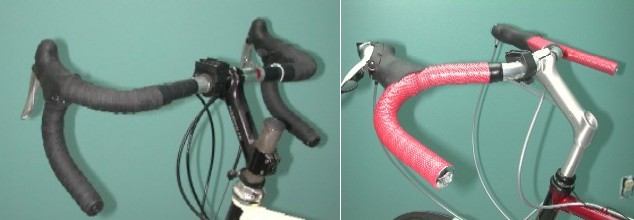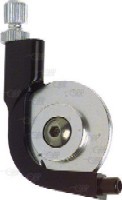

|
This article talks about the various handlebars available in the US and the issues involved in changing bars.
Personally, when I think about touring, I think about having a handlebar that is the right height and shape to provide a variety of hand positions. (well, lots of other things too, but this is one of them) Since I will have a significant amount of weight on my hands for many hours a day, it's really nice to be able to move them around so I don't have constant pressure from one position.
The most common handlebars I've seen people use for touring are:


![]()
![]()
Straight (mountain bike style) handlebars are not the best choice because of the limited positions they offer. You can put your hands on the grips and inboard, on the brake levers. While this is a good position for power and control, riding with your elbows pointing out is not generally comfortable for long periods. Plus, you catch more wind, which slows you down considerably.
You can increase the number of positions by attaching an æro bar to the handlebars or by adding bar ends. This gives a third, and sometimes a fourth, hand position.
If you are planning to ride on dirt roads or other difficult surfaces where the control offered by wide straight bars is important, you may want to consider combinations of a straight bar and add-ons. See Sheldon's IRO bike's handlebar setup.
What most people decide on is traditional dropped road handlebars. Drop bars give you (normally) 4 hand positions: Middle of the bar...On the corners...On the hoods...On the drops.

If you have this style already and find you seldom or never ride in the drops, then maybe you should consider raising the bars so you can get more positions and greater comfort. See Sheldon's article on handlebar height. Hands Up! Adjusting Handlebar Height
Raising the handlebars can be as simple as inserting a stem raiser (the black item in the picture)

between your existing stem and the fork's steering tube. Or as complex as installing a new long-quill road style (see Nitto Technomic) stem . If you raise your bars a lot, you will likely also need to replace the brake and/or shifter cables with longer ones.
If you raise the handlebars more than 2 or so inches on most production road bikes with modern integrated brake/shifter units, the brake and shift housings will be too short. You will need to replace the housing sections from the integrated shifters/brakes (brifters) to the downtube cable stops. You will also need new cables, since the old ones will now be too short.
![]()
![]()
Euro touring bars work similarly to drop bars. Except instead of your hand positions going up and down, Euro bar hand positions go forward and back. One good benefit of Trekking handlebars over drop bars, is that the 'side' hand position gives you alot of leverage when climbing with a heavy load. The versions in these pictures are 55cm wide.

You can ride on the inner flats, the sides, the front curves, and on the 'hoods'. Well, it's not technically on the hoods, but you position the hands on the sides of the brake levers.
With Euro bars, you are not dropping down , but reaching farther forward. This creates a more stretched out position, which tends to lower one somewhat, but not as much as with drop bars. If you are replacing drop bars with these bars, you would normally also replace the stem with one that is shorter by 2-4cm to achieve a similar reach.
Most Moustache handlebars ride like Trekking handlebars, except without the close-in position. Riding on the curves is the primary hand position.

![]()
![]()
The compatibility to note is the clamp diameter of the stem and the clamp diameter of the handlebar. The current ISO standard , and the most common, is 25.4 mm.
See Sheldon's glossary item on stems
If you are using a stem with one clamp bolt, check the handlebar and stem you want to use to make sure the two are compatible.
If you decide to replace your stem, you will need to know if it is a "quill" type for threaded headsets, or a "Threadless" design. If you aren't sure which one your bike has, Check Sheldon's Glossary item on Headsets
No matter which system your bike uses, I recommend getting a stem whose face plate is detachable. So called, 'pop top ' stems have 2 (or occasionally 4) bolts on the front of the stem to clamp the handlebar. This allows you to change stems without having to unwrap handlebar tape and remove brake levers. Much more convenient, especially when you are trying to find the right rise and reach for comfortable touring. Any of the 25.4, 26.0 handlebar diameters can be clamped securely in a 'pop-top' stem. If you are not sure what they look like, all the stems shown in the handlebar pictures are 'pop-top' style.
Mountain bikes (and hybrids) can make OK touring bikes. They have relaxed geometry, lots of room for large tires and fenders, good brakes and a fairly upright riding position. Some people who already have a mountain bike or a hybrid want to put road drop bars on them and use them for touring and commuting.
However: The common mountain bike straight handlebar, the hybrid upright handlebar, and Trekking bar diameter are all 7/8" (22.2 mm.) This is not the diameter where the stem clamps , but the diameter of the rest of the handlebar, where one mounts the brakes and shifters. However, this is smaller than the current road handlebar diameter of 15/16" (23.8 mm.) See Sheldon's handlebar crib sheet
Therefore, your existing 'mountain bike' shifters and brake levers won't fit on drop handlebars. All of Shimano's current (Alivio, Acera, STX, Deore, LX, XT and XTR) mountain bike shifters and brakes use aluminum housings and handlebar clamps. So do the ones made by SRAM. These cannot be widened enough to fit onto the larger road diameter bars. If you try, you will probably crack the aluminum housing. (I know, I've tried.) Even if you could mount them, the brake levers curve in the wrong direction.
![]()
![]()
Finding a drop handlebar with the same diameter as your existing mountain bike handlebar is unlikely. The only ones of which I am aware are old cheapo steel drop bars. Not a solution I would recommend.
If you have direct-pull ("V type") brakes , you will need to increase the amount of cable your brake lever can pull. Otherwise, you will have to set the brake pads very close to the rims. This can be a problem if your wheels aren't exactly in true.
The 3 options to solve this problem are:
Cable 'ratio changers', such as the Problem Solvers "Travel Agent". This device consists of two pulleys that effectively increase the amount of cable pulled at the brake.


They are the only road style brake levers (of which I am aware) designed to pull the larger amount of cable required for "V" brakes found on most current mountain bikes.
If your bike has hydraulic discs, then you cannot easily change to another type of lever, as hydralic brake sets are designed as a package of lever, master cylinder, slave cylinder and caliper. Your choice in this situation is to either stay with your existing brake system and use Trekking or other compatible diameter handlebars, or change to a mechanical disc brake set and drop bars.
![]()
![]()